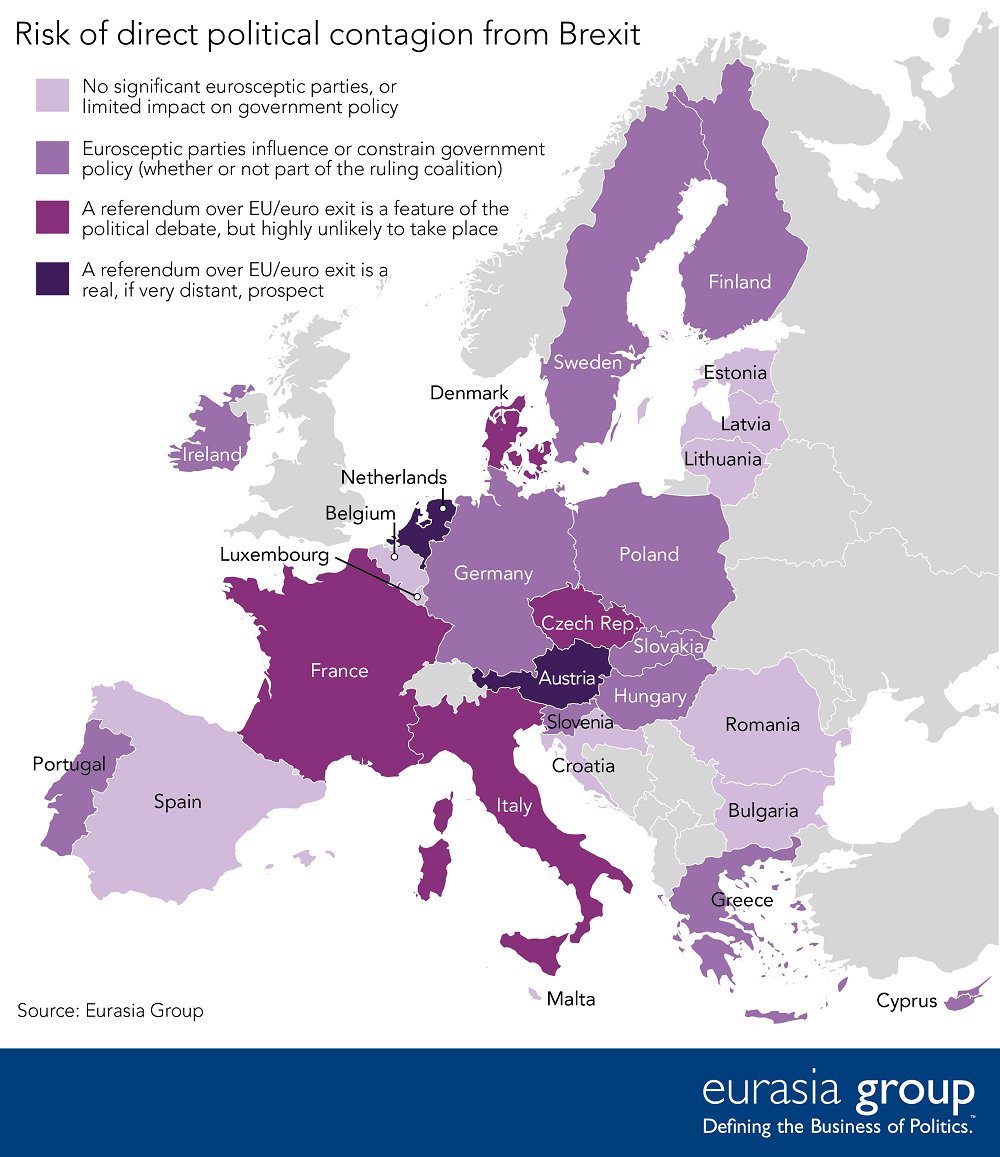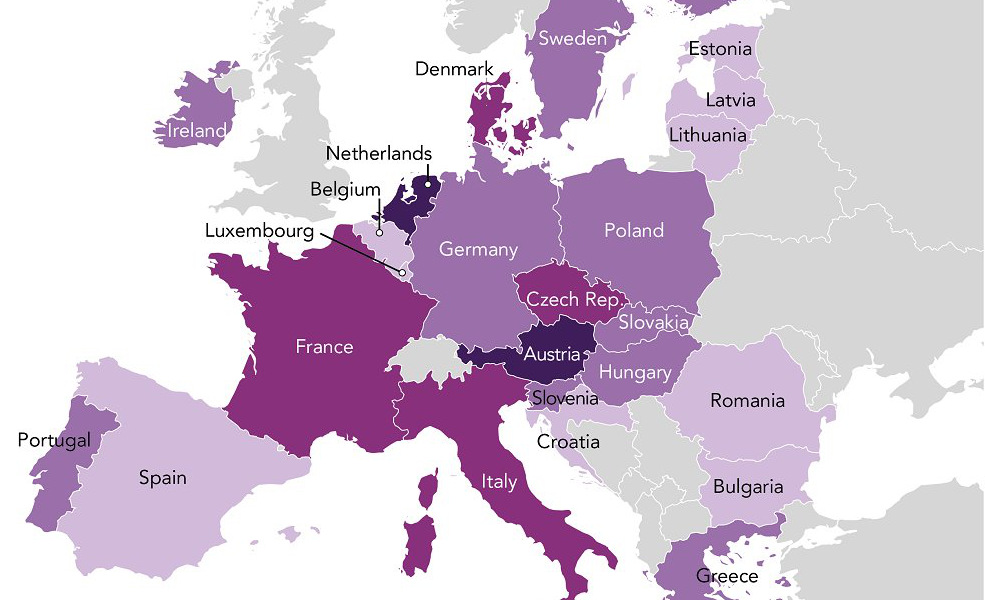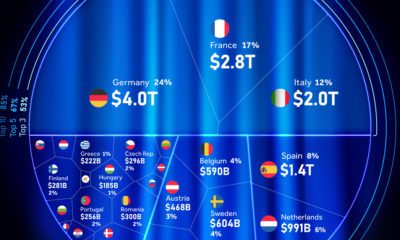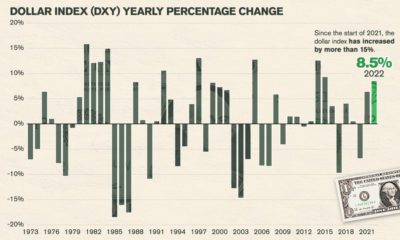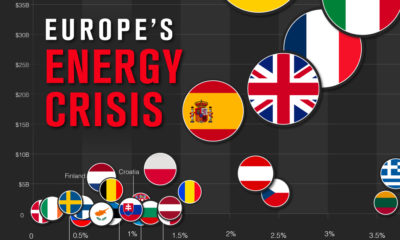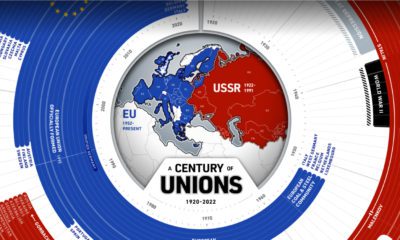Eurasia Group, a geopolitical risk consultancy, shared this map today after analyzing EU countries for the potential of further Brexit-like events:
It’s not the type of quantitative data we usually seek, but in this case we’ll make an exception – Eurasia Group, headed by Ian Bremmer, is the largest political consultancy in the world.
Austrout or Nexit?
According to Eurasia’s analysis, the two countries that are most likely to have referendums on EU membership are Austria and The Netherlands. It’s been 20 years since Austria held the referendum to initially join the EU. However, according to a pre-Brexit poll, nearly 40% of the population now wants to hold a referendum to leave. “Europe can collapse because of the refugee crisis and uncontrolled immigration,” says Sebastian Kurz, the Austrian Foreign Minister. “Only by a speedy transformation can we prevent a wildfire. The EU needs to be rearranged. Everyone, who is for Europe, also needs to be a force in making the necessary changes.” In other words, there must be fast, sweeping changes to their arrangement or they are out. Unfortunately, making fast, sweeping decisions is not what the European Union is known for. The Dutch share a similar sentiment. Despite Netherlands being a founding member of the EU and currently holding the EU presidency, a June poll showed 54% of people want a referendum to leave. So far, in a theoretical vote, the independence camp is leading with 48% of the vote, while 45% would seek to remain in the EU.
What’s Next?
While Eurasia Group sees Austria and the Netherlands as the frontrunners for the next referendum vote, there are many other dominoes that could fall. France, Italy, and Sweden are among the key countries that have strong Eurosceptic movements. If a Brexit result was a tinderbox that got the fire going, then any major developments in these countries could be the gasoline. Another “exit” event would make clear to everyone that there is an inevitability of failure around the Union. Brexit negotiations and populist dissent will be in the news for some time, and markets will be volatile, extremely sensitive, and over-reactive as a result.
on Even while political regimes across these countries have changed over time, they’ve largely followed a few different types of governance. Today, every country can ultimately be classified into just nine broad forms of government systems. This map by Truman Du uses information from Wikipedia to map the government systems that rule the world today.
Countries By Type of Government
It’s important to note that this map charts government systems according to each country’s legal framework. Many countries have constitutions stating their de jure or legally recognized system of government, but their de facto or realized form of governance may be quite different. Here is a list of the stated government system of UN member states and observers as of January 2023: Let’s take a closer look at some of these systems.
Monarchies
Brought back into the spotlight after the death of Queen Elizabeth II of England in September 2022, this form of government has a single ruler. They carry titles from king and queen to sultan or emperor, and their government systems can be further divided into three modern types: constitutional, semi-constitutional, and absolute. A constitutional monarchy sees the monarch act as head of state within the parameters of a constitution, giving them little to no real power. For example, King Charles III is the head of 15 Commonwealth nations including Canada and Australia. However, each has their own head of government. On the other hand, a semi-constitutional monarchy lets the monarch or ruling royal family retain substantial political powers, as is the case in Jordan and Morocco. However, their monarchs still rule the country according to a democratic constitution and in concert with other institutions. Finally, an absolute monarchy is most like the monarchies of old, where the ruler has full power over governance, with modern examples including Saudi Arabia and Vatican City.
Republics
Unlike monarchies, the people hold the power in a republic government system, directly electing representatives to form government. Again, there are multiple types of modern republic governments: presidential, semi-presidential, and parliamentary. The presidential republic could be considered a direct progression from monarchies. This system has a strong and independent chief executive with extensive powers when it comes to domestic affairs and foreign policy. An example of this is the United States, where the President is both the head of state and the head of government. In a semi-presidential republic, the president is the head of state and has some executive powers that are independent of the legislature. However, the prime minister (or chancellor or equivalent title) is the head of government, responsible to the legislature along with the cabinet. Russia is a classic example of this type of government. The last type of republic system is parliamentary. In this system, the president is a figurehead, while the head of government holds real power and is validated by and accountable to the parliament. This type of system can be seen in Germany, Italy, and India and is akin to constitutional monarchies. It’s also important to point out that some parliamentary republic systems operate slightly differently. For example in South Africa, the president is both the head of state and government, but is elected directly by the legislature. This leaves them (and their ministries) potentially subject to parliamentary confidence.
One-Party State
Many of the systems above involve multiple political parties vying to rule and govern their respective countries. In a one-party state, also called a single-party state or single-party system, only one political party has the right to form government. All other political parties are either outlawed or only allowed limited participation in elections. In this system, a country’s head of state and head of government can be executive or ceremonial but political power is constitutionally linked to a single political movement. China is the most well-known example of this government system, with the General Secretary of the Communist Party of China ruling as the de facto leader since 1989.
Provisional
The final form of government is a provisional government formed as an interim or transitional government. In this system, an emergency governmental body is created to manage political transitions after the collapse of a government, or when a new state is formed. Often these evolve into fully constitutionalized systems, but sometimes they hold power for longer than expected. Some examples of countries that are considered provisional include Libya, Burkina Faso, and Chad.
